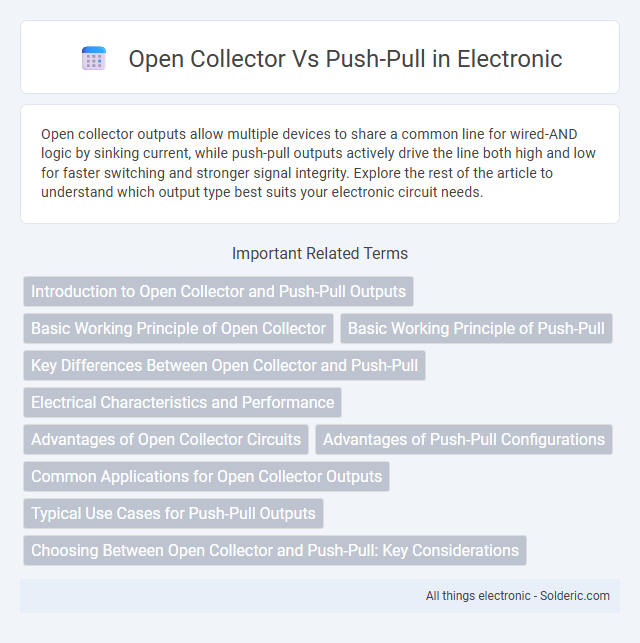Open collector outputs allow multiple devices to share a common line for wired-AND logic by sinking current, while push-pull outputs actively drive the line both high and low for faster switching and stronger signal integrity. Explore the rest of the article to understand which output type best suits your electronic circuit needs.
Comparison Table
| Feature | Open Collector | Push-Pull |
|---|---|---|
| Output Type | Transistor open-drain or open-collector transistor output | Complementary transistor pair (push and pull both) |
| Voltage Levels | Requires external pull-up resistor to define output high voltage | Drives both high and low levels actively |
| Power Consumption | Lower static power; power depends on pull-up resistor | Higher power due to active driving of output states |
| Speed | Slower rise time due to passive pull-up resistor | Faster switching and edge transitions |
| Wiring | Allows wired-AND connections (multiple outputs tied together) | No wired-AND capability; outputs should not be shorted |
| Applications | Open-drain buses (I2C), level translation, LED driving | General purpose digital outputs, high-speed switching |
| Fail-safe Behavior | Default to high impedance when off, can pull line low | Actively drive both high and low; risk of shoot-through if misconfigured |
Introduction to Open Collector and Push-Pull Outputs
Open Collector outputs use a transistor to pull the output line to ground, requiring an external pull-up resistor to achieve a high state, making them ideal for wired-AND logic and level shifting. Push-Pull outputs actively drive the line both high and low, providing faster switching speeds and stronger signal integrity without needing external components. Understanding the differences between Open Collector and Push-Pull outputs is essential for designing efficient digital circuits and choosing the appropriate output stage for specific applications.
Basic Working Principle of Open Collector
Open Collector outputs use a transistor to pull the line to ground, requiring an external pull-up resistor to achieve a high logic level, enabling multiple devices to share a single communication line without conflict. This configuration allows wired-AND logic, as the line is only actively driven low or left floating, relying on the pull-up resistor to set the high state. The Open Collector design is ideal for level shifting and interfacing with different voltage domains in digital circuits.
Basic Working Principle of Push-Pull
Push-pull output stages use two transistors that alternately drive the output high or low, providing active sourcing and sinking of current for better switching performance. This topology reduces power dissipation and improves signal integrity by ensuring faster transitions with less distortion compared to open collector outputs. Your choice of push-pull can enhance speed and efficiency in digital and analog circuit designs.
Key Differences Between Open Collector and Push-Pull
Open Collector outputs allow multiple devices to share a single line by sinking current to ground, requiring an external pull-up resistor for voltage control. Push-Pull outputs actively drive the line both high and low, enabling faster switching speeds and stronger signal integrity. Key differences lie in load-driving capabilities, signal speed, and the necessity of external components, making Open Collector ideal for wired-AND configurations and Push-Pull preferable for high-speed digital communication.
Electrical Characteristics and Performance
Open collector outputs use a transistor that can only pull the line to ground, requiring an external pull-up resistor to achieve a high state, resulting in slower rise times and increased power dissipation during switching. Push-pull outputs contain both pull-up and pull-down transistors, enabling faster switching speeds, reduced power loss, and stronger drive capability for both high and low voltage levels. Open collector designs excel in wired-AND logic and level shifting, while push-pull is preferred for driving loads requiring rapid transitions and low output impedance.
Advantages of Open Collector Circuits
Open collector circuits offer significant advantages in interfacing different voltage levels and creating wired-AND logic configurations without additional components. Their open-drain design allows multiple outputs to be connected to a single line, enabling easy bus communication and fault-tolerant systems. You benefit from simplified circuitry and increased flexibility in mixed-voltage environments when using open collector outputs.
Advantages of Push-Pull Configurations
Push-pull configurations offer faster switching speeds and greater efficiency by actively driving both high and low output states, reducing power dissipation compared to open collector designs. Your circuits benefit from improved signal integrity and reduced electromagnetic interference due to symmetrical drive capability. These advantages make push-pull outputs ideal for high-speed digital communication and precise analog applications.
Common Applications for Open Collector Outputs
Open collector outputs are commonly used in applications requiring wired-AND logic, such as bus communication lines and interrupt signals in microcontroller systems. They are ideal for driving multiple devices from a single output line without causing contention, frequently seen in alarm systems, LED matrix displays, and relay driving circuits. Their ability to interface with various voltage levels makes them suitable for mixed-voltage systems and open-drain bus topologies like I2C.
Typical Use Cases for Push-Pull Outputs
Push-pull outputs are commonly used in digital circuits requiring fast switching speeds and strong drive capabilities, such as microcontroller GPIO pins interfacing directly with LEDs, relays, or other digital devices. These outputs efficiently source and sink current, making them ideal for applications needing precise voltage levels and minimal signal distortion. Their ability to actively drive both high and low states suits them for bidirectional data lines and high-speed communication protocols like SPI and I2C.
Choosing Between Open Collector and Push-Pull: Key Considerations
Choosing between Open Collector and Push-Pull outputs depends on your circuit's voltage requirements and load characteristics. Open Collector outputs are ideal for wired-AND connections and level shifting across different voltages, while Push-Pull outputs provide faster switching and stronger drive capability. Your decision should consider factors like power consumption, signal speed, and compatibility with other components.
Open Collector vs Push-Pull Infographic

 solderic.com
solderic.com